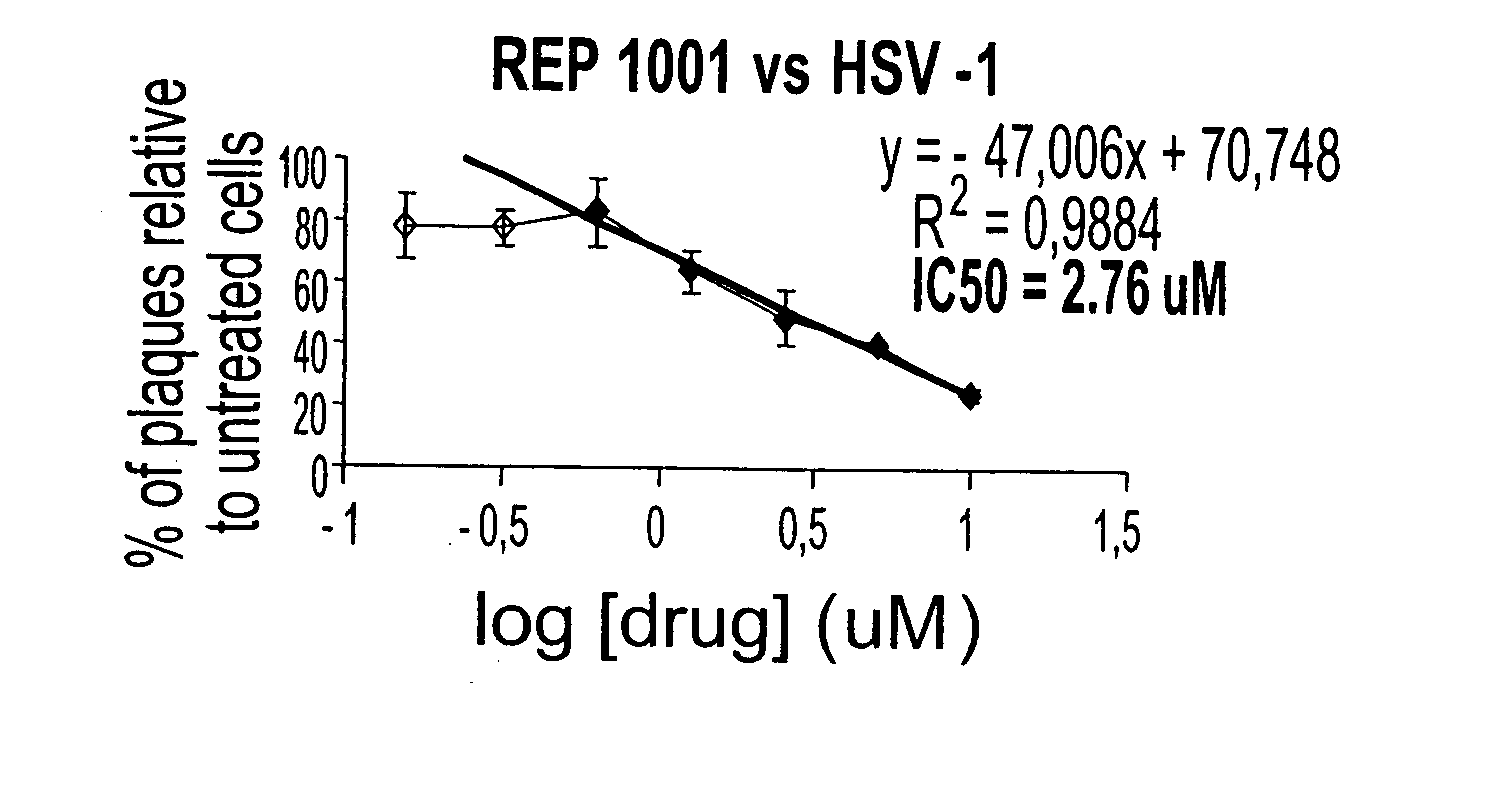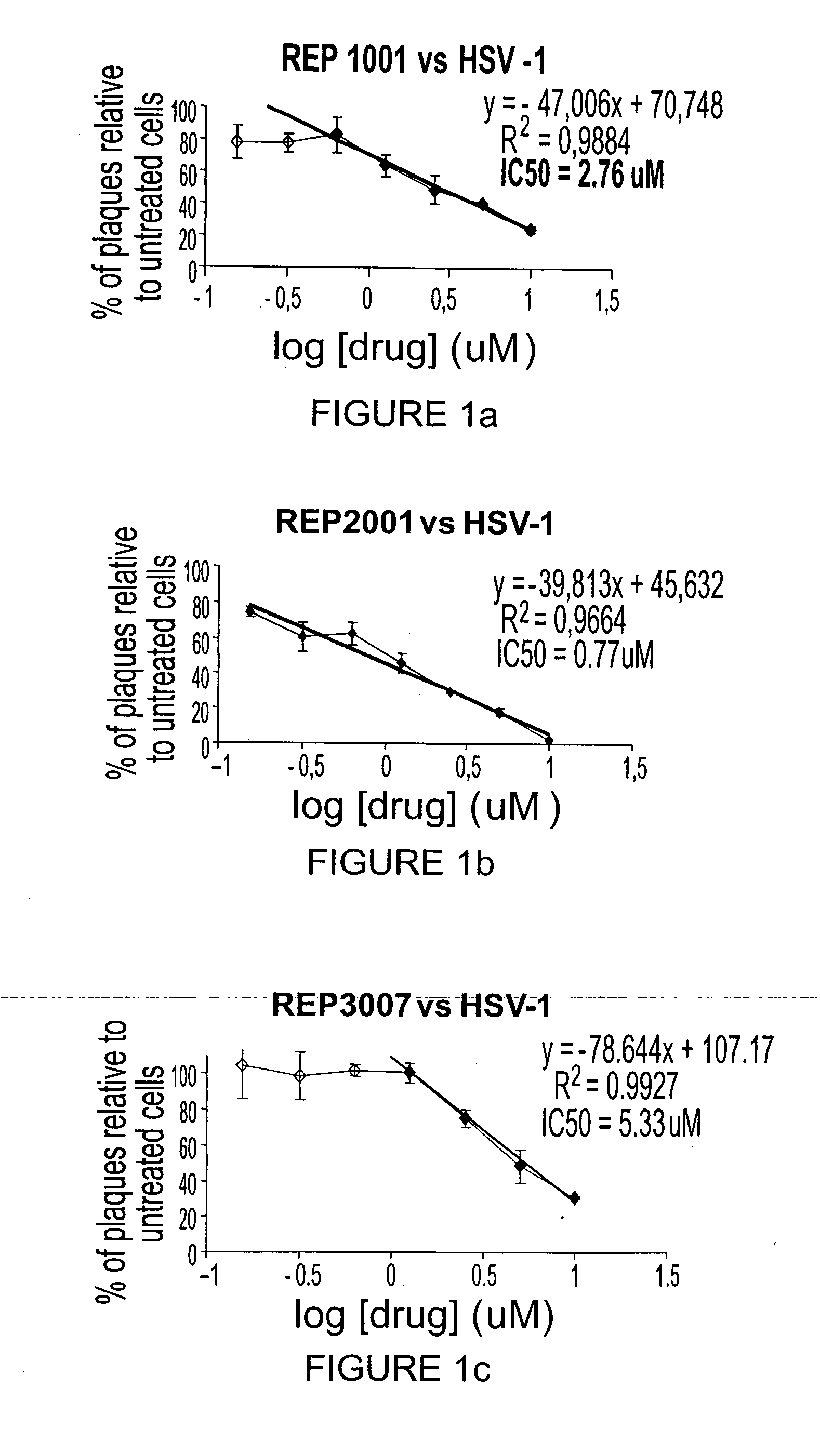Antiviral oligonucleotides targeting viral families
a technology of oligonucleotides and viral families, applied in the direction of biocide, peptide/protein ingredients, genetic material ingredients, etc., can solve the problems of increased risk of infection, congenital abnormalities, and frequent death of diseases, so as to prolong the duration of the presence of diseases, prevent or reduce interactions
- Summary
- Abstract
- Description
- Claims
- Application Information
AI Technical Summary
Benefits of technology
Problems solved by technology
Method used
Image
Examples
example 1
Herpes Simplex Virus
[0343] Herpes simplex virus (HSV) affects a significant proportion of the human population. It was found in the present invention that random ODNs or ODN randomers inhibited the infectivity of viruses such as HSV. Using cellular HSV replication assays in VERO cells (susceptible to HSV-1 (strain KOS) and HSV-2 (strain MS2) infection) it was found that a single stranded PS-ODN complementary to the HSV origin of replication inhibited replication of HSV-1 and HSV-2. Surprisingly, control PS-ODNs complementary to human (343 ARS) and plasmid (pBR322 / pUC) origins also inhibited viral infectivity. Experiments with random sequence PS-ODNs and PS-ODN randomers demonstrated that inhibition of viral infection increased with increasing ODN size. These data show that ONs are potent antiviral agents useful for therapeutic treatment of viral infection.
[0344] The inventors have theorized that a potential mechanism for blocking the spread of viruses such as HHVs was to prevent t...
example 2
Inhibition of HSV-2
[0353] The ability of PS-ODNs to inhibit HSV-2 is measured by PRA. Immortalized African Green Monkey kidney (VERO) cells are cultured at 37° C. and 5% CO2 in MEM plus 10% fetal calf serum supplemented with gentamycin, vancomycin and amphoterecin B. Cells are seeded in 12 well plates at a density which yields a confluent monolayer of cells after 4 days of growth. Upon reaching confluency, the media is changed to contain only 5% serum plus supplements as described above and cells are then exposed to HSV-2 (strain MS2, approximately 40-60 PFU total) in the presence of the test compound for 90 minutes. After viral exposure, the media is replaced with new “overlay” media containing 5% serum, 1% human immunoglobulins, supplements as described above and the test compound. Plaque counting is performed 34 days post infection following formalin fixation and cresyl violet staining of infected cultures.
[0354] To test if PS-ODNs could inhibit HSV-2, REP 1001, 2001 and 3007 a...
example 3
Inhibition of CMV
[0359] The ability of PS-ODNs to inhibit CMV is measured in a plaque reduction assay (PRA). This assay is identical to the assay used for testing anti-HSV-1 and anti-HSV-2 except that CMV (strain AD169) is used as the viral innoculum and human fibroblasts were used as cellular host.
[0360] To test the size dependence and sequence independence of PS-ODNs on anti-CMV activity, we test PS-ODN randomers that vary in size (see FIG. 16a, b). When these PS-ODNs are tested in the CMV PRA, we find that as the size of the PS-ODN increases, the potency also increases (IC50 decreases, see FIG. 16c).
[0361] To more clearly elucidate the effective size range for PS-ODN anti-CMV activity, we tested PS-ODN randomers covering a broader range of sizes from 10 to 80 bases. We also included several clinically accepted small molecule CMV treatments (Gancyclovir, Foscarnet and Cidofovir) as well as 2 versions of a marketed antisense treatment for CMV retinitis, (Vitravene™; commercially...
PUM
| Property | Measurement | Unit |
|---|---|---|
| molecular weight | aaaaa | aaaaa |
| molecular weight | aaaaa | aaaaa |
| molecular weight | aaaaa | aaaaa |
Abstract
Description
Claims
Application Information
 Login to View More
Login to View More - R&D
- Intellectual Property
- Life Sciences
- Materials
- Tech Scout
- Unparalleled Data Quality
- Higher Quality Content
- 60% Fewer Hallucinations
Browse by: Latest US Patents, China's latest patents, Technical Efficacy Thesaurus, Application Domain, Technology Topic, Popular Technical Reports.
© 2025 PatSnap. All rights reserved.Legal|Privacy policy|Modern Slavery Act Transparency Statement|Sitemap|About US| Contact US: help@patsnap.com



